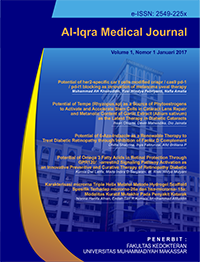POTENSI KOMBINASI MEMANTIN DAN FITOMELATONIN DARI EKSTRAK BIJI BUNCIS (PHASEOLUS VULGARIS L) TERENKAPSULASI NANO-CHELATOR SEBAGAI INHIBITOR AGREGASI β-AMILOID DAN ANTIOKSIDAN : MODALITAS KURATIF MUTAKHIR PADA PENDERITA ALZHEIMER
DOI:
https://doi.org/10.26618/aimj.v3i2.4159Keywords:
Alzheimer, combination, Memantine, Melatonine, and nano-chelatorAbstract
Alzheimer merupakan penyakit yang menyerang sistem saraf pusat manusia dengan tanda adanya atrofi dan kematian saraf pada beberapa regio di otak. Data dari World Health Orginazation (WHO) pada tahun 2017 menunjukkan angka penderita Alzheimer mencapai 50 juta orang dan di Indonesia mencapai 1,2 juta orang. Tatalaksana yang ada saat ini belum dapat mengobati Alzheimer secara menyeluruh dan tingginya ketidakpatuhan pasien dalam menjalani pengobatannya membuat angka penderita Alzheimer tetap tinggi. Mengetahui kombinasi memantin dan fitomelatonin yang terenkapsulasi nano-chelator sebagai terapi kuratif Alzheimer. Metode yang digunakan adalah studi literatur. Penulis menganalisis sumber-sumber terkait yang mayoritas berasal dari jurnal yang diambil dari PubMed, Science Direct, dan Spinger. Memantin merupakan obat yang telah dipakai dalam pengobatan Alzheimer dengan memblok reseptor NMDA sehingga melindungi sel saraf dari reaksi inflamasi dan menghambat pembentukan agregasi β-Amilod. Namun, penggunaan satu bahan tersebut tidak dapat menunjukkan hasil yang maksimal. Oleh karena itu, penulis mengkombinasikan memantine dengan fitomelatonin yang didapatkan dari buncis (Phaseolus vulgaris L) dengan peran sebagai antioksidan dan mengurangi agregasi β- Amilod melalui jalur yang berbeda dari memantin. Untuk meningkatkan bioavabilitas, ketepatan terapi, dan kemampuan menembus Blood-Brain Barrier (BBB) dari kedua bahan tersebut maka digunakanlah nano-chelator. Melalui efek penghambatan pembentukan agregasi β- Amilod dan antioksidan dari kombinasi memantin dan melatonin dengan enkapsulasi nano- chelator diharapkan terapi Alzheimer dapat lebih efektif dan efisien.
References
Association A. 2012 Alzheimer ’ s disease facts and figures. Alzheimer’s Dement [Internet]. 2012;8(2):131–68. Available from: http://dx.doi.org/10.1016/j.jalz.2012.02.001
Gaugler J, James B, Johnson T, Scholz K, Weuve J. 2016 Alzheimer’s disease facts and figures. Alzheimer’s Dement [Internet]. 2016;12(4):459– 509. Available from: http://dx.doi.org/10.1016/j.jalz.2015.02.003
Iturria-Medina Y, Sotero RC, Toussaint PJ, Mateos-Pérez JM, Evans AC. Early role of vascular dysregulation on late-onset Alzheimer’s disease based on multifactorial data-driven analysis. Nat Commun. 2016;7(1).
World Health Organization (WHO). 2019. Dementia Fact Sheets.https://www.who.int/news- room/fact-sheets/detail/dementia
Alzheimer’s Association. 2019. Dementia Statistic. Alzheimer’s Dementia 2019. https://www.alz.co.uk/research/statistics
Menkes RI. 2016. Demensia Usia Lansia. Kemenkes RI:Jakarta [Diakses 30 Juli 2020]
Alzheimer Indonesia. 2019. Statistik tentang Demensia.https://alzi.or.id/statistik-tentang- demensia/
Kumar A, Singh A, Ekavali. A review on Alzheimer’s disease pathophysiology and its management: An update. Pharmacol Reports [Internet]. 2015;67(2):195–203. Available from: http://dx.doi.org/10.1016/j.pharep.2014.09.004
Edmonds, E. C., McDonald, C. R., Marshall, A., Thomas, K. R., Eppig, J., Weigand, A. J., Bondi, M. W. (2019). Early versus late MCI: Improved MCI staging using a neuropsychological approach. Alzheimer’s & Dementia. doi:10.1016/j.jalz.2018.12.009
Zheng H, Koo EH. Biology and pathophysiology of the amyloid precursor protein. 2011;1(Figure 1):1–16.
Wang, X., Wang, W., Li, L., Perry, G., Lee, H., & Zhu, X. (2014). Oxidative stress and mitochondrial dysfunction in Alzheimer’s disease. Biochimica et Biophysica Acta
Wollen, KA. Alzheimer’s Disease: The Pros and Cons of Pharmaceutical, Nutritional, Botanical, Ana Stimulatory Therapies, with a Discussion of Treatment Strategies from the Perspective of Patients and Practitioners. Alternative Medicine Review. 2010; 15(3):223-244.
Alzheimer assocation.2019. FDA-approved treatments for Alzheimer.
Danysz, W., & Parsons, C. G.
(2012). Alzheimer’s disease, β-amyloid, glutamate, NMDA receptors and memantine - searching for the connections. British Journal of Pharmacology, 167(2), 324–
doi:10.1111/j.1476-5381.2012.02057.x
B. Arnao, M.; Hernández-Ruiz, J. 2018. The Potential of Phytomelatonin as a Nutraceutical. Molecules 2018, 23, 238. https://doi.org/10.3390/molecules23010238
Salehi, B.; Sharopov, F.; Fokou, P.V.T.; Kobylinska, A.; Jonge, L.D.; Tadio, K.; Sharifi- Rad, J.; Posmyk, M.M.; Martorell, M.; Martins, N.; Iriti, M. Melatonin in Medicinal and Food Plants: Occurrence, Bioavailability, and Health Potential for Humans. Cells 2019, 8, 681 https://doi.org/10.3390/cells8070681
Arnao MB, Hernández-Ruiz J. Phytomelatonin, natural melatonin from plants as a novel dietary supplement: Sources, activities and world market. J Funct Foods 2018;48:37–42. https://doi.org/10.1016/j.jff.2018.06.023.
Wang, C. F., Song, C. Y., Wang, X., Huang, L. Y., Ding, M., Yang, H., Wang, P., Xu, L. L., Xie, Z. H., & Bi, J. Z. (2019). Protective effects of melatonin on mitochondrial biogenesis and mitochondrial structure and function in the HEK293-APPswe cell model of Alzheimer’s disease. European Review for Medical and Pharmacological Sciences, 23(8), 3542–3550. https://doi.org/10.26355/eurrev_201904_17723
Jürgenson, M., Zharkovskaja, T., Noortoots, A., Morozova, M., Beniashvili, A., Zapolski, M., & Zharkovsky, A. (2019). Effects of the drug combination memantine and melatonin on impaired memory and brain neuronal deficits in an amyloid‐predominant mouse model of Alzheimer’s disease. Journal of Pharmacy and Pharmacology. doi:10.1111/jphp.13165
Liu, G., Men, P., Perry, G., & Smith, M. A. (2009). Nanoparticle and Iron Chelators as a Potential Novel Alzheimer Therapy. Free Radicals and Antioxidant Protocols, 123– 144. doi:10.1007/978-1-60327-029-8_8
Li, X., Jankovic, J., & Le, W. (2010). Iron chelation and neuroprotection in neurodegenerative diseases. Journal of Neural Transmission, 118(3), 473–477

